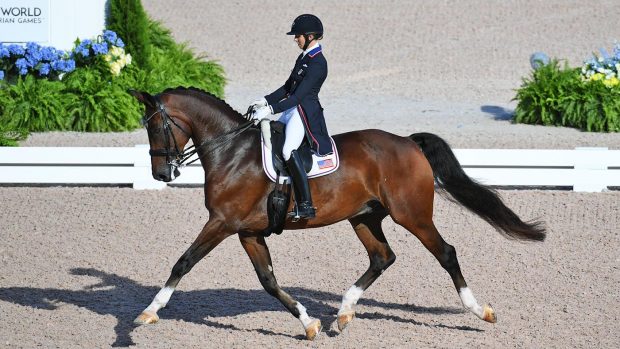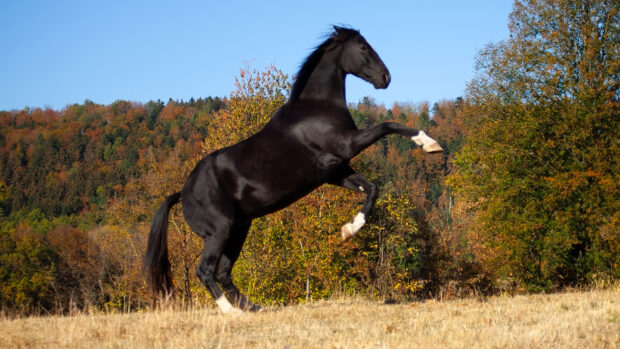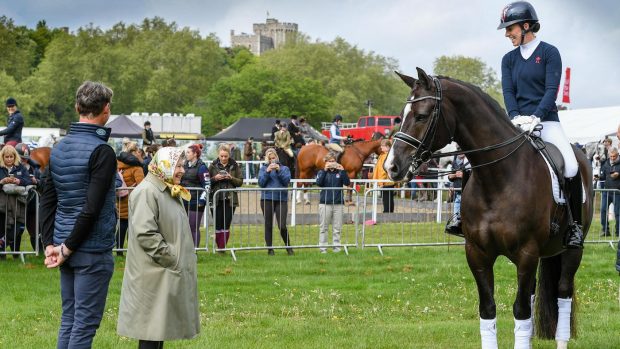The 2024 Paris Olympics are almost upon us, and while we marvel at the efforts of today’s top riders, spare a thought for the colossal exploits of yesteryear’s stars with the challenges of a more experimental phase of equestrianism.
The Olympic motto Citius, Altius, Fortius – “faster, higher, stronger” – certainly applied to the early days of organised equestrianism.
One of the first recorded showjumping courses was at Madison Square Gardens in 1892, six fences of 1.75m to 1.83m (5ft 9in–6ft). The New York Times reported that one faller “had a narrow escape from bad injury, as he landed on the top of his head, and was spun about like a top, his foot caught in the stirrup”.
Sixty years later in New York, post-war icon Pat Smythe tackled similar rails – now thoughtfully cushioned by bamboo wrapping! For those brought up in the era of accuracy fences and nuanced distances, the archives leave you gasping, “Did they seriously jump that?”
The arena sport derived from high-jump contests in the late 19th century. Military riders galloped their multitasking steeds at fearsome sloping rails and other gimmicky obstacles.
In one famous photograph from 1904, Georges Crousse clears 2.20m (7ft 3in) while saluting the King of Spain. Contemporary sports writer Gustav Rau chastised riders for showing off, and looking back over the fence. The obsession with record-breaking fizzled out only after World War II, as civilians made showjumping their own.
The Hickstead Derby track gives a glimpse into the “natural” presentation of bygone showjumping, with its plethora of banks – invariably with gullies or hedges on the landing side – railway crossings and waters.
Uniformity did not arrive until the late 1960s.
Double Hickstead
Derby winner Alison Dawes (née Westwood) says: “Each show had its own style of jumps – so you always knew where you were. We saw a lot of spreads filled solidly on the landing side, and hexagonal or square-edge poles. You could give them quite a clout, until it was realised round poles were easier to knock down.”
One edifice at the Swiss show at Frauenfeld was known as the “monument”. Horses were encouraged to slide down the side of a bank, landing in water. Nice in France had many idiosyncratic feature fences, including a triple bar over some 12ft of water, a parallel of walls splaying out around the base, and a hollowed out bank with rails in the gap.
Several ditches were dug in the hallowed turf of Wembley Stadium for the 1948 Olympic jumping, their subsiding levels making them even more “starey” and eliminating many when, because of rationing, the London Water Board turned off the supply. Only one combination cleared the final water of 4.72m (15ft 6in) on what we’d now call a related distance to a 1.60m wall. Humberto Mariles and the one-eyed Arete had enough time-penalties in hand to afford four faults, so deliberately splashed through for double gold.

The 1968 Mexico second-round showjumping course was considered “unjumpable”
David Broome, whose illustrious career spanned post-war and modern eras, says: “People don’t realise how big we used to jump. The water was often 16ft – whereas it’s 13ft today. In the olden days it was about setting records. When [German course-designer] Olaf Petersen came along he made it more technical, and that saved the sport in a lot of ways, though we’ve gone away from testing a horse’s bravery.”
A big wall was standard in grand prix tracks. The second round of the Olympic individual at Mexico City 1968 included a wall at 1.80m, an oxer (cleared by only two) at 1.75m and a triple with a back rail of 1.70m, both with 2.20m spread. By contrast, in modern Olympics there is a maximum 1.65m height and 2m spread, except for triple bars at 2.20m.
Marion Mould (née Coakes) and Stroller won individual silver but were eliminated in the Nations Cup. Alison Dawes, their non-riding team-mate, says such heartbreaking tracks were deemed never to happen again: “They’d used a local course-builder and everyone said, ‘He’s a lunatic – his courses will be unjumpable for anything a little bit careful.’ Until Mexico, Stroller had never met something he couldn’t jump; so sad.”

Captain Raguse (USA) during the cross-country phase in Doeberitz, 1936
The 1968 Olympic cross-country was equally notorious, for its floods; non-swimmer Tommy Brennan (Ireland) was among several washed downstream, to be rescued by then FEI president, Prince Philip, the Duke of Edinburgh.
Team gold medallist Jane Holderness-Roddam (née Bullen) says the course would have been startling even if dry.
“Two fences were almost Pony Club, tiny piles of logs, but then you’d find a post and rail across a bridge with no sides, jumping from concrete to concrete. At fence five you hurtled off a ledge over a river with 8ft drop. Our Nobby was so out of control we practically went through the string by the VIP chalet.”
“Skinnies” were a faraway glint in the course-builder’s eye. This did not stop riders being regularly presented with “alien” concepts. Frank Weldon, Badminton director from 1969 to 1988, was the master “rider frightener,” putting his spin on Continental innovations such as Denmark’s Horsens Bridge – a huge drop invisible until the last second by solid rails off a ramp.

Above: Frank Weldon – pictured with the Duke of Beaufort in 1986 – was the master “rider frightener” as Badminton director
In 1977 Lucinda Green was convinced George would fall at Badminton’s first-ever bounce at the Lake. In those days of survival tests, George sailed through, also clearing Vicarage Ditch just as the bank collapsed in heavy rain (another occupational hazard until bases were routinely riveted) to return her third of six Badminton wins.
Yet bold horses could equally be confused by “new” questions. In 1973, Rachel Bayliss and Gurgle The Greek went under the trakehner – without penalty. In 1988, Murphy Himself launched himself off the Ski Jump – 3ft 6in logs atop a steep slope – in one go. World champion Ginny Elliot (née Leng) broke her ankle, and passed the ride to Ian Stark.
“At my first Badminton, there was the first-ever bounce from ditch to post-and-rails – it was chaos!” said Jane. “Even [three-time winner] Sheila Willcox stopped there; the horses simply didn’t know what they were expected to do.”
Another notorious track was the 1978 World Championship at Lexington, worsened by extreme heat. There was a Normandy bank with a 5ft 11in drop into water and the truly treacherous Serpent, a triple combination with two turns over three fences, complicated by water and angles. Old Fort Lexington was a treble combination of small cabins to a 3ft 7in bank topped by a 2ft stockade.
When asked how he would take the following ditch and rails, Japan’s Kuranjo Saito – who’d spent two years in the US training solely for this event – replied sadly: “Not get so far.”
Celebrated five-star course-designer Mike Etherington-Smith admits a fondness for the “old” sport, despite fences he would not dream of including today, such as vertical rails midway down a slope or the double bounce.
“I remember hacking down to the Normandy Bank and getting flashes of ‘this might hurt’,” recalls Mike. “People didn’t have the depth of consciousness about what works and is fair to horses. Now, we have to be more sophisticated.
“We are more mindful of the ‘balloon’ going up if you show the layman unpleasant images, but we never know if we’re doing the right thing for maybe five years. It’s a discussion we old codgers have all the time!”

The 1968 Olympic cross-country course was notorious for its floods, with several riders washed downstream
It’s easy to overlook that before Britain became its spiritual home, eventing already had a long and colourful history.
At the 1936 Berlin Olympic cross-country, 35 of 50 starters were submerged upon landing in a sludgy pond. Bowie Knife, ride of Britain’s Richard Fanshawe, extricated himself and galloped off. A search party found him 4km away, tied to a tree. He was brought back, remounted and jumped clear. The escapade cost Fanshawe some 8,500 time-penalties but as only one of three teams to complete, Britain bagged its first-ever Olympic bronze.
Dressage at the first equestrian Olympics at Stockholm 1912 included five jumps at 3ft 6in, and an obedience test, walking past strange objects; that idea did not last long. But while modern-day excellence and the demographic involved bears no comparison, the actual sporting test of dressage has changed little over the years.
Four-time Olympian Jennie Loriston-Clarke recalls the biggest shake-up was the introduction of the freestyle – she was at the vanguard in the 1980s with Dutch Gold.
“Even the Germans were ‘anti’ the kür at first,” says Jennie. “No one would have imagined it would one day help decide the Olympic individual gold [from 1996.] People would complain that dressage to music wasn’t ‘classical’ and I’d reply, ‘Then why do they do it at the Spanish Riding School?’
“Kyra Kyrklund was the master of intricate new movements. I did some quite catchy things, too, such as piaffe into canter pirouette, and one-time changes down the long side.”

Above: Henri Saint Cyr, Olympic dressage champion in 1956. While the sport itself has changed little, the standard is incomparable
Loyalty to tradition means that the standard size of a dressage arena has never changed – 20x60m was the gap between “huts” on 19th-century German military barracks where informal dressage competitions took place. The seemingly random markers derive from letters over the doors of various personnel – P for Pferknecht (groom,) B for Bannertrager (standard bearer) and so on.
“I learnt the main ones by remembering it’s ‘heck’ [HEK] down one side and ‘more bloody fools’ [MBF] down the other!” says Jennie.
You may also be interested in…
With the 2020 Games postponed a year by the coronavirus pandemic, Pippa Roome looks back on other Olympics that have
This year marks the 70th anniversary of the 1948 London Olympics, and things look a little different today than they

The Olympics in adversity: how past Games have been affected by world events, from wars to boycotts

#TBT: 70 years since the 1948 London Olympics (things looked a little different…)

Subscribe to Horse & Hound magazine today – and enjoy unlimited website access all year round
Horse & Hound magazine, out every Thursday, is packed with all the latest news and reports, as well as interviews, specials, nostalgia, vet and training advice. Subscribe today and enjoy the magazine delivered to your door every week, plus unlimited website access and digital versions of the magazine dating back to September 2012.




